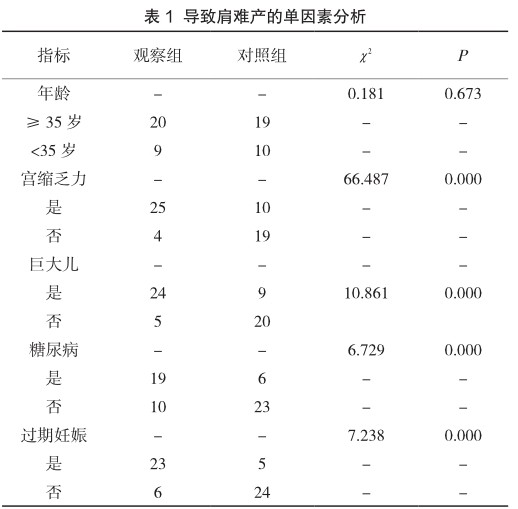探讨巨大儿肩难产发生的高危因素及临床处理措施


打开文本图片集
【摘 要】目的:分析探究巨大儿肩难产发生的高危因素及临床处理措施。方法:在2019年1月至2020年12月选择29例肩难产患者为观察组,并选择同期正常阴道分娩产妇29例为对照组,首先采用单因素分析和Logistic回归分析导致肩难产的相关危险因素,并比较两组不同产程时间。结果:经单因素分析发现糖尿病、宫缩乏力、过期妊娠以及巨大儿属于其影响因素(P
【关键词】高危因素;巨大儿;临床处理措施;肩难产
To explore the high-risk factors and clinical treatment measures for the occurrence of huge shoulder dystocia
Liu Weiwei
Cangzhou Nanpi people’s Hospital, Hebei Cangzhou Hebei 061500, China
【Abstract】Objective:To analyze and explore the high-risk factors and clinical treatment measures for the occurrence of gigantic shoulder dystocia.Methods:From January 2019 to December 2020, 29 patients with shoulder dystocia were selected as the observation group,and 29 patients with normal vaginal delivery during the same period were selected as the control group. Firstly,univariate analysis and logistic regression analysis were used to analyze the related risk factors of shoulder dystocia,and compare the two groups of different labor time. Results:Univariate analysis found that diabetes, uterine weakness, prolonged pregnancy, and macrosomia were among its influencing factors(P
【Key?Words】High-risk factors; Giant infants; Clinical treatment measures; Shoulder dystocia
肩难产属于产科中产妇分娩的不良并发症之一,其主要指的是胎儿头部娩出后其肩膀卡在母体骨盆出口处无法顺利分娩的情况,根据相关研究统计发现肩难产的发生率大约在0.15%~1.75%[1-2]。(剩余3214字)
网站仅支持在线阅读(不支持PDF下载),如需保存文章,可以选择【打印】保存。